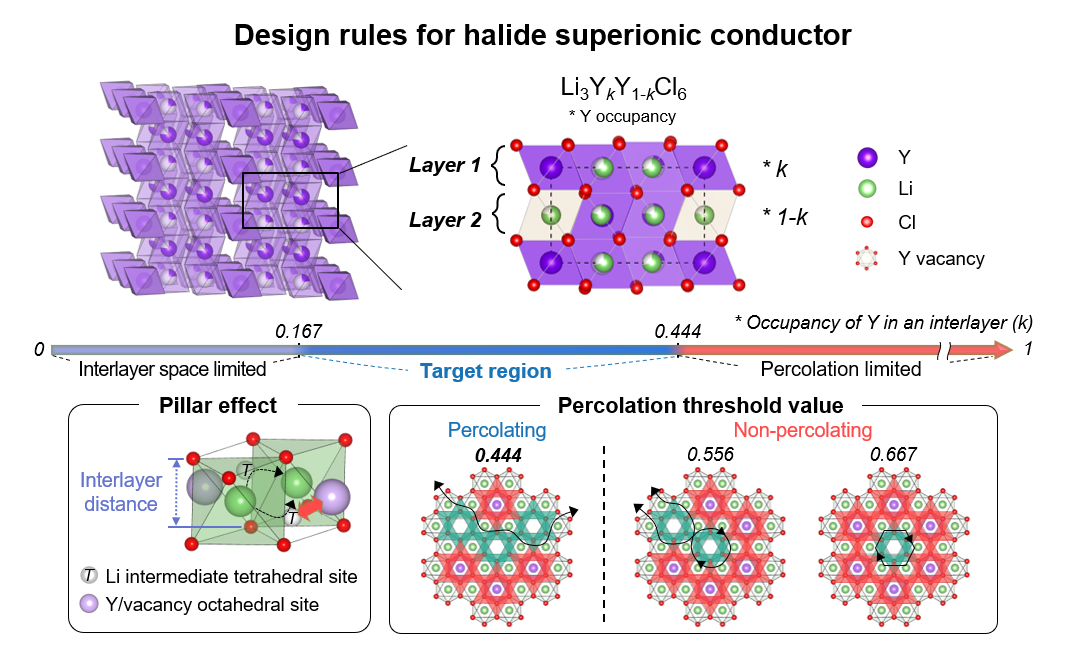2023-11-03 韓国基礎科学研究院(IBS)
 Figure 1. Design Strategy for Trigonal Chloride Solid Electrolytes
Figure 1. Design Strategy for Trigonal Chloride Solid Electrolytes
The arrangement of metal ions (yttrium in this case) within each layer affects the ionic conductivity. To ensure the unobstructed movement of lithium ions, the number of metal ions occupying available sites within each layer should be less than 0.444. Furthermore, to create a sufficiently wide pathway for lithium ions within each layer, the occupancy of metal ions should be more than 0.167. Therefore, achieving an occupancy of metal ions between 0.167 and 0.444 within each layer results in a conductive layer with high ionic conductivity
◆固体電池技術は、液体電解質に依存する従来の電池の安全性の問題を解決するために重要です。この研究は、金属イオンの分布に焦点を当て、イオン伝導性を向上させる新しい戦略を開発し、希土類金属を使用せずにコスト効果の高い固体電池を実現しました。これにより、固体電池の商業化とエネルギー蓄積の安全性が向上する可能性があります。
<関連情報>
- https://www.ibs.re.kr/cop/bbs/BBSMSTR_000000000738/selectBoardArticle.do
- https://www.science.org/doi/10.1126/science.adg6591
カチオンの秩序-無秩序を制御することによる3ハロゲン化物超イオン伝導体の設計 Design of a trigonal halide superionic conductor by regulating cation order-disorder
Seungju Yu,Joohyeon Noh,Byunghoon Kim,Jun-Hyuk Song,Kyungbae Oh,Jaekyun Yoo,Sunyoung Lee,Sung-O Park,Wonju Kim,Byungwook Kang,Donghyun Kil,Kisuk Kang
Science Published:2 Nov 2023
DOI:https://doi.org/10.1126/science.adg6591
Editor’s summary
Lithium-metal-halides behave as superionic conductors and show stability at high operating voltages, thus making them suitable candidates for solid state batteries. Although several mechanisms for this behavior have been suggested, a detailed analysis of each one and its overall significance has been lacking. Yu et al. studied a family of hexagonal close-packed stacked trigonal halides with the general formula of Li3MCl6, where M is a metal ion such as yttrium (see the Perspective by Van der Ven). Using a combination of computational methods, the authors observed the importance of having partial occupancy of the metal in developing two critical structural characteristics: the existence of a percolating network and the maintenance of an appropriate interlayer distance. —Marc S. Lavine
Abstract
Lithium-metal-halides have emerged as a class of solid electrolytes that can deliver superionic conductivity comparable to that of state-of-the-art sulfide electrolytes, as well as electrochemical stability that is suitable for high-voltage (>4 volt) operations. We show that the superionic conduction in a trigonal halide, such as Li3MCl6 [where metal (M) is Y or Er], is governed by the in-plane lithium percolation paths and stacking interlayer distance. These two factors are inversely correlated with each other by the partial occupancy of M, serving as both a diffusion inhibitor and pillar for maintaining interlayer distance. These findings suggest that a critical range or ordering of M exists in trigonal halides, and we showcase the achievement of high ionic conductivity by adjusting the simple M ratio (per Cl or Li). We provide general design criteria for superionic trigonal halide electrolytes.



